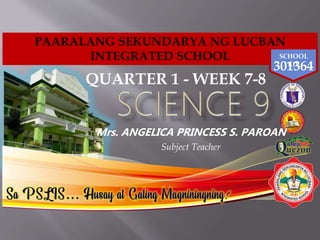
WEEK 7-8 SCIENCE 9.pptx
- 1. SCHOOL I.D. 301364 Mrs. ANGELICA PRINCESS S. PAROAN Subject Teacher QUARTER 1 - WEEK 7-8
- 3. In an ecosystem, organisms need a balance environment. A balance ecosystem is on which living thing and non-living thing interacting harmoniously. If any part of the ecosystem is disturbed, other will also be affected.
- 4. Differentiate basic features and importance of photosynthesis and respiration.
- 7. All organisms need energy to sustain life.
- 8. Forms of
- 9. In order to sustain life, all organisms require energy, but not all of them can use light energy directly for life activities.
- 10. To provide the energy needed by all organisms, plants and other chlorophyll-bearing organisms capture the energy of sunlight and convert it into chemical energy stored in the food.
- 11. When people and other heterotrophic organisms eat food from producers and consumers, chemical energy stored from food is transferred to their bodies.
- 12. How do plants manufacture their own food? What are the factors that affect the rate of photosynthesis? How do cells convert stored energy in food into chemical energy? How do materials and energy flow in the ecosystem?
- 14. Photosynthesis is a process of food making done by plants and other autotrophic organisms.
- 16. CHLOROPHYLL - enables these organisms to make their own food.
- 17. Autotrophic organisms require light energy, carbon dioxide (CO2), and water (H2O) to make food (sugar).
- 19. Pictures of leaves and stem
- 20. Plants have two different types of transport tissue. Xylem transports water and solutes from the roots to the leaves, phloem transports food from the leaves to the rest of the plant.
- 21. - the process by which water evaporates from the leaves, which results in more water being drawn up from the roots.
- 22. The chlorophyll is built into the membranes of the thylakoids. Chlorophyll absorbs white light but it looks green.
- 24. White light is consists of three primary colors: red, blue, and green. Only red and blue light is absorbed thus making these colors unavailable to be seen by our eyes while the green light is reflected which makes the chlorophyll looks green.
- 25. However, it is the energy from red light and blue light that are absorbed and will be used in photosynthesis.
- 26. The green light that we can see is not absorbed by the plant and thus, cannot be used in photosynthesis.
- 29. happens in the presence of light. occurs in the thylakoid membrane converts light energy to chemical energy. Water-one of the raw materials of photosynthesis-is utilized during this stage Water also facilitates the formation of free electrons and oxygen
- 30. The energy harvested during this stage is stored in the form of ATP (Adenosine Triphosphate) and NADPH ( Nicotinamide Adenine Dinucleotide Phosphate Hydrogen). These products will be needed in the next stage to complete photosynthetic process.
- 31. takes place in the stroma converts Carbon dioxide (CO2) into sugar. does not directly need light but needs the products of light reaction. it occurs immediately after the light-dependent phase.
- 33. Plants have green pigments called chlorophyll stored in the chloroplast. This pigment aids in capturing light energy from the sun that enables plants to change it into chemical energy stored in the food. This process is called photosynthesis.
- 34. Stomata are found on the lower surface of the leaf that allows the entrance of carbon dioxide needed for photosynthesis. They also serve as exit point for the oxygen produced during photosynthesis.
- 37. RECALL! Respiration is the process of taking oxygen from the air and cycling it through the lungs, which then gives oxygen to blood to be used in the body. The carbon dioxide waste is expelled out of the lungs.
- 38. Cellular respiration uses glucose or sugars, from food molecules and turns them into carbon dioxide, water, and ATP a nucleotide essential to the body.
- 39. Cellular respiration can occur both aerobically (using oxygen), or anaerobically (without oxygen).
- 40. During aerobic cellular respiration, glucose reacts with oxygen, forming ATP that can be used by the cell. Carbon dioxide and water are created as byproducts
- 42. WHAT I KNOW (PRETEST) ACVITITY 1,2,3 ASSESSMENT